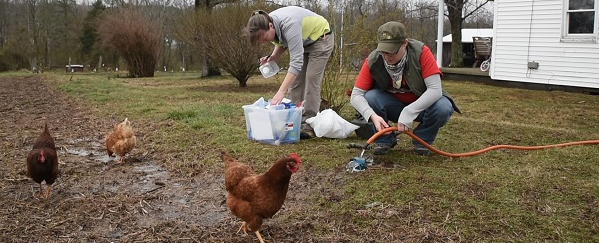Voinovich School’s solar water quality measurement tool sees early application
Since 2013, students, staff and faculty with the Energy and Environment team at Ohio University’s Voinovich School of Leadership and Public Affairs have been developing a technology allowing for simpler, longer-term water quality testing in the field. Now, that technology is seeing its first real-world application through its deployment in another Voinovich School project.
The goal of the new technology has been to utilize solar panels to power instruments that analyze water quality. The use of solar panels represents an advance from traditional, battery-powered systems of water quality monitoring, as data is transferred wirelessly rather than manually, thereby improving both the frequency and efficiency of data collection.
“Using solar panels allows us to keep the technology in the field for longer periods,” said Sebastian Teas, a recent graduate of the Master’s of Science in Environmental Studies program who worked on the technology for most of his time at the Voinovich School. “In contrast to the other technologies that are available, we can collect the data digitally, rather than bringing the equipment back to campus.”
“This technology allows us to continually monitor water, permitting longer-term data collection,” added Nora Sullivan, an environment specialist with the Voinovich School who works on the project.
Sullivan hopes that the technology will eventually be capable of remote data transmission such that it will require very little maintenance in the field. This would allow it to alert people very quickly when water quality declines, as well as allowing for the system’s practical application in inaccessible or remote locations.
The project was first funded with an 1804 grant in partnership with OHIO’s information and telecommunications systems program. Thanks to additional funding from an Ohio University Innovation Strategy Planning Grant for the development of environmental technologies, the project then expanded to partner with the College of Arts and Sciences, Russ College of Engineering and Scripps College of Communications. Funding is also provided by the Appalachian New Economy Partnership (ANEP), a program of the Ohio Department of Higher Education and the state legislature.
Right now, however, the project is still in its early stages. Two monitoring devices are in use within southeast Ohio, with two additional devices awaiting deployment, and the Voinovich School is troubleshooting the technology in partnership with OHIO’s information technology department. The collected data could contribute to a broad array of future research, but is currently supplementing another project at the Voinovich School, funded by the Sugar Bush Foundation and titled, “Bringing Transparency to Environmental Issues Surrounding Class II Injection Wells through Community Engagement.”
The injection well study seeks to assess the impact of hydraulic fracturing wastewater injection on water quality near Torch, Ohio. Researchers share the results of the study with residents and community members, as they simultaneously facilitate trainings and workshops designed to help the community understand and communicate scientific information while navigating issues of legislation, regulations and public information access. Partners on the project include the Buckeye Environmental Network, the Athens County Fracking Action Network and Torch CAN DO.
“The community in southeast Ohio is concerned that highly contaminated water is being injected into their water,” said Jen Bowman, director of environmental programs at the Voinovich School and the coordinator of watershed research efforts with the Appalachian Watershed Research Group. “It is important that we work with the community to give them the language and tools that they need to be able to communicate with legislators and representatives.”
In 2015 alone, more than four million barrels of waste from oil and gas extraction in Ohio and nearby states were disposed in hundreds of injection wells within Ohio. The wastewater contains potentially large quantities of undisclosed, toxic chemicals and the impact of the waste’s injection is unmonitored by the government. The Voinovich School’s study will allow local communities to better understand the consequences of wastewater injection and to use that information to better advocate for their community’s well-being.
The Voinovich School is monitoring groundwater quality in partnership with 14 landowners near Torch injection wells, who have allowed the School to monitor their drinking water wells. Additionally, the School plans to utilize the data collected by its solar-powered surface water monitoring technology to supplement groundwater analysis.
“When we delve into a topic, we try to look at all its different angles, so we use all the resources we can,” Bowman said.
In addition to helping the communities of southeast Ohio through the injection well study, the solar-powered water monitoring technology has also contributed to the education of students throughout Ohio University and the community.
“The project taught me a lot about research and development,” Teas said of his time working on the project as a master’s student. “No professor can tell students what exactly is going wrong with the project when something isn’t working, so students learn how to deal with the unknown and to make discoveries themselves.”
Aside from the Voinovich School graduate students who have worked on the project over the past few years, a doctoral student, a Voinovich Undergraduate Research Scholar, a high school student, and several students with OHIO’s information technology department have contributed to the project’s success.
“Students have had to develop the whole project, asking questions like what hardware we need, how to mount the device, and more,” Sullivan said. “They have had to think through the entire process, start to finish.”
